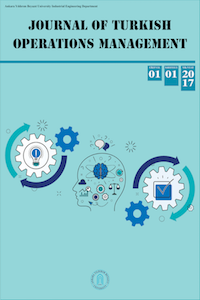ASSESSMENT AND CREATION OF LIVESTOCK SUPPLY CHAIN MANAGEMENT
ASSESSMENT AND CREATION OF LIVESTOCK SUPPLY CHAIN MANAGEMENT
Livestock Supply Chain, Agent Based Simulation Framework System Analysis & Design, Design of Experiment,
___
- Ahumada, O., & Villalobos, J. R. (2009). Application of planning models in the agri-food supply chain: A review. European journal of Operational research,196(1), 1-20.
- Aiyun, G., Debin, D., & Zhongwei, H. (2010, May). RFID in the livestock supply chain management: application and development. In E-Business and E-Government (ICEE), 2010 International Conference on (pp. 3424-3427). IEEE.
- Banhazi, T. M., & Black, J. L. (2009). Precision livestock farming: a suite of electronic systems to ensure the application of best practice management on livestock farms. Australian Journal of Multi-disciplinary Engineering, 7(1), 1-14.
- Boyer, C. N., & Brorsen, B. W. (2013). Changes in beef packers’ market power after the livestock mandatory price reporting act: An agent-based auction. American Journal of Agricultural Economics, aat005.
- Den Ouden, M., Nijsing, J. T., Dijkhuizen, A. A., & Huirne, R. B. M. (1997). Economic optimization of pork production-marketing chains: I. Model input on animal welfare and costs. Livestock Production Science, 48(1), 23-37.
- Guerrin, F. (2004). Simulation of stock control policies in a two-stage production system: Application to pig slurry management involving multiple farms. Computers and Electronics in Agriculture, 45(1), 27-50.
- Guo, X., Claassen, G. D. H., Lansink, A. O., & Saatkamp, H. W. (2014). A conceptual framework for economic optimization of single hazard surveillance in livestock production chains. Preventive veterinary medicine, 114(3), 188-200.
- Hassini, E., Surti, C., & Searcy, C. (2012). A literature review and a case study of sustainable supply chains with a focus on metrics. International Journal of Production Economics, 140(1), 69-82.
- Herold, P., Roessler, R., Willam, A., Momm, H., & Zárate, A. V. (2010). Breeding and supply chain systems incorporating local pig breeds for small-scale pig producers in Northwest Vietnam. Livestock Science, 129(1), 63-72.
- Kumar, A. (2007). From mass customization to mass personalization: a strategic transformation. International Journal of Flexible Manufacturing Systems, 19(4), 533-547.
- Lazic, Z. R. (2006). Design of experiments in chemical engineering: A practical guide. John Wiley & Sons.
- Marsden, T., Banks, J., & Bristow, G. (2000). Food supply chain approaches: exploring their role in rural development. Sociologia ruralis, 40(4), 424-438.
- Matt, D. T., Rauch, E., & Dallasega, P. (2015). Trends towards Distributed Manufacturing Systems and modern forms for their design. Procedia CIRP, 33, 185-190.
- Pomar, J., López, V., & Pomar, C. (2011). Agent-based simulation framework for virtual prototyping of advanced livestock precision feeding systems. Computers and electronics in agriculture, 78(1), 88-97.
- Rich, K. M., Baker, D., Negassa, A., & Ross, R. B. (2009, August). Concepts, applications, and extensions of value chain analysis to livestock systems in developing countries. In International Association of Agricultural Economists Conference, August, Beijing.
- Rich, K. M., Ross, R. B., Baker, A. D., & Negassa, A. (2011). Quantifying value chain analysis in the context of livestock systems in developing countries. Food Policy, 36(2), 214-222.
- Shamsuddoha, M. (2011, June). Reverse supply chain process as environmental sustainability in the poultry industry of Bangladesh. In Curtin University, Curtin Business School, Doctoral Colloquium.
- Soysal, M., Bloemhof-Ruwaard, J. M., & Van der Vorst, J. G. A. J. (2014). Modelling food logistics networks with emission considerations: The case of an international beef supply chain. International Journal of Production Economics,152, 57-70.
- Uwizeye, A., Gerber, P. J., Schulte, R. P., & de Boer, I. J. (2016). A comprehensive framework to assess the sustainability of nutrient use in global livestock supply chains. Journal of Cleaner Production, 129, 647-658.
- van der Gaag, M. A., Vos, F., Saatkamp, H. W., van Boven, M., van Beek, P., & Huirne, R. B. (2004). A state-transition simulation model for the spread of Salmonella in the pork supply chain. European Journal of Operational Research, 156(3), 782-798.
- Van der Vorst, J. G., Tromp, S., & van der Zee, D. J. (2005, December). A simulation environment for the redesign of food supply chain networks: Modeling quality controlled logistics. In Proceedings of the 37th conference on Winter simulation (pp. 1658-1667). Winter Simulation Conference.
- Van der Vorst, J. G., Tromp, S. O., & Zee, D. J. V. D. (2009). Simulation modelling for food supply chain redesign; integrated decision making on product quality, sustainability and logistics. International Journal of Production Research, 47(23), 6611-6632
- ISSN: 2630-6433
- Başlangıç: 2017
- Yayıncı: Ankara Yıldırım Beyazıt Üniversitesi
Two-stage MCDM approach in the selection of manager training techniques
Gülsüm ALICIOĞLU, Aylin ADEM, Metin DAĞDEVİREN
ASSESSMENT AND CREATION OF LIVESTOCK SUPPLY CHAIN MANAGEMENT
Deniz EFENDİOĞLU, Beytullah Gültekin ÇETİNER
